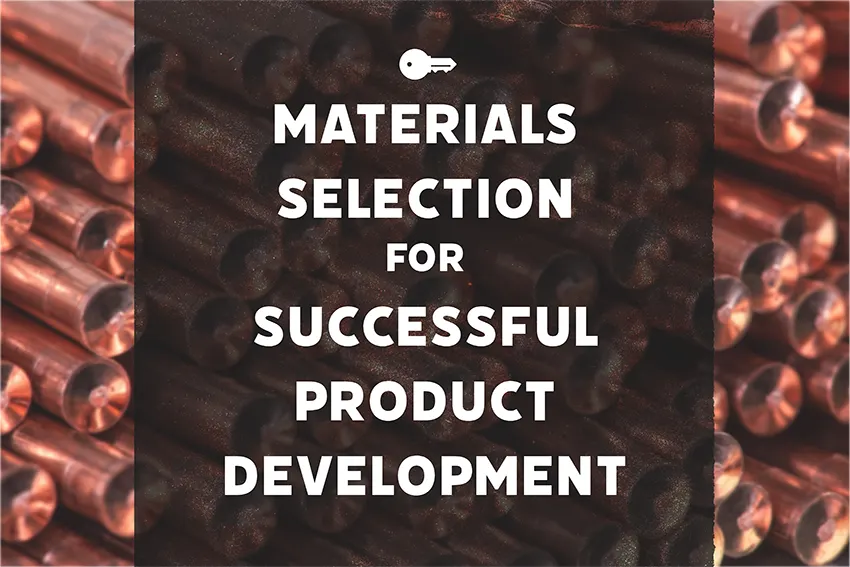Key Materials Considerations for Successful Product Development
Choosing the right materials for your product is vital to long-term success. Many factors must be assessed to create a functional, successful product. Traditional concerns, such as cost and performance, are as important as ever, while environmental impact is a newer factor that must be considered.

PARTS OBSOLESCENCE
When developing a product, it is important to consider the life cycle of its components. Obsolescence describes parts that have fallen out of use or are incompatible with new technology. When a product reaches its end-of-life, it is no longer sold or maintained by the manufacturer.
Be aware of the life cycle of your components during product design; if you’re mass producing a next-gen laptop, don’t choose an LCD screen that won’t be readily available in three months. While it is possible to redesign components, and it may be necessary to improve and maintain your product over time, designing a product with components that have an end-of-life in sight creates more work in the future and could lead to delays in production while the product is redesigned.
PERFORMANCE REQUIREMENTS
Electrical Conductivity
A vital component of electronics is materials with high electrical conductivity. Metals are the most common conductive materials, although some non-metals can become conductive through doping by oxidation, which creates metallic properties.
Silver is the best conductor of electricity; however, due to its high cost, it is not the most used metal. Copper is commonly used, as it costs less than silver and is still highly conductive. Steel and aluminium are also seen. Gold is desirable for its high conductivity and resistance to tarnishing, which silver is susceptible to. However, gold’s high cost makes it less common than copper.
Thermal Management
Thermal management is vital to maintaining a system’s operating temperature. Metallic conductivity generates heat, which can lead to device failure if this heat is not managed. Fans are a typical form of thermal management. They move out the warm air and replace it with cooler air. Heat sinks are conductive metals attached to the heat source that transfer heat out of the source and into the surrounding environment. The heat then dissipates from the heat sink’s large surface area, sometimes with the aid of a fan.
Consider how people will use the product. A treadmill, for instance, will be used for long periods of time, so the motor needs to be cooled. Treadmills also require a robust casing that can absorb the weight and impact from running. Additionally, the exterior may be wiped down with cleaning products often, so a material durable enough to withstand regular contact with chemical agents is necessary. This consideration is also critical when designing medical equipment, as is biocompatibility.
ENVIRONMENTAL IMPACT
Electronics manufacturing is not traditionally an environmental industry, from plastic components to pollution to waste when consumers discard old products. However, there are ways to lessen its impact on the environment.
Recycled plastics and bioplastics, which are produced from renewable resources, are sustainable alternatives to conventional plastic. Recycled glass is also a viable option for electronics. Additionally, choosing a domestic manufacturing site or one near where the product will be distributed reduces pollution created in transport and saves on import taxes and tariffs. Products that save on energy use have become more popular as well.
Environmental Regulations for Electronics Manufacturing
Restrictions of Hazardous Substances (RoHS) standards regulate the percentage of hazardous substances allowed in products to protect the health of humans and animals. Originally a 2003 EU directive, the UK kept the regulations in place after leaving the EU, only changing the marking requirement from a CE mark to the UKCA mark for products placed on the Great Britain market.
The RoHS directive restricts the use of 10 substances, including cadmium, lead, and mercury, to 0.1% or less of each hazardous substance per product. Manufacturers, importers, and distributors are responsible for ensuring their products comply with the RoHS.
The United States has not adopted the RoHS at a federal level, but several states have enacted regulations based on the directive. State regulations vary on the types of products and hazardous substances included in the restrictions. To be sold on the global market, products must be registered in various systems and attain multiple product markings. It is important to know all the regional restrictions that may apply to your product during materials selection.
COST
Pence matters when mass-producing a product. What may not seem like a consequential amount of money saved per part can add up to a large sum on significant production runs. Choosing a cheaper material is not the only way to save money. Quantity discounts may also be available, where unit cost decreases as the quantity bought increases.
Short lead times can also save on costs. It is important to work with a strong supply chain team that can promptly source the most cost-effective materials for your product.
Aesthetics and Ergonomics
Choosing the correct materials for your product’s functionality is vital, but do not overlook aesthetics. When people spend money on a product, they want it to look good and align with their vision of the product’s purpose. In design, ergonomics means the product is comfortable to use and fits the intended need. For example, the running belt of a treadmill should be designed with ergonomics in mind to reduce stress on users’ joints, and it should be durable. Smartwatches not only need to be durable and water resistant, but should also be comfortable for the wearer, lightweight, and look good.
Compatibility and Integration
Be sure that all your components are compatible. Electrical components should have equivalent voltage ranges and materials with thermal properties should have similar expansion rates. Everything should fit together in the design specification and work harmoniously in the final product.
Consider the product assembly process. Small electronic components that can be used in pick-and-place machines are more efficient and cost-effective, as they can be assembled in seconds.
The Importance of Materials Selection
Materials selection is an essential aspect of the product development process. The materials will influence cost, aesthetics, environmental impact, and, ultimately, a product’s success. Sustainability is increasingly becoming a focus through the use of sustainable materials, reduced emissions, and environmental regulations.
A strong supply chain team can efficiently and effectively acquire parts. A team with an early-warning system will also be aware of any changes in the supply chain that could affect manufacturing and time to market.
Pivot International’s multi-disciplined engineering teams design with materials selection in mind. We ensure all components work and fit together seamlessly to provide the most sophisticated product for our partners. Our global supply chain teams throughout Europe, Asia, and North America work together to source the highest quality and cost-effective parts. Contact us to learn how our teams can seamlessly design your next product.

